
The Blogs Turn 10: Looking Back, Looking Ahead by Chris Peterson SM '13
data and narrative, past and present
Cruftblogging 2014
Last week the blogs turned ten. We celebrated by asking a bunch of former bloggers to come back and blog for us. In case you missed it, here’s an index of their entries:
- 50 Reflections by Ben Jones
- Right back where we started from by Mollie B. ’06
- Cue the montage music by Melis A. ’08
- I Remember… by Anthony R. ’09
- Reflecting on 10 Years by Kim D. ’09
- Fake it ’til you make it by Laura N. ’09
- How To Fumble Your Way Through MIT and Still Turn Out Pretty Okay by Keri G. ’10
- Thank you for reading by Jess K. ’10
- ADMIT ME PLZ? by Chris S. ’11
- Life slows down a bit – if you let it by Snively ’11
- MIT: Round 2 by Becca H. ’12
- Imbibing the Nostalgia Punch by Rachel F. ’12
- Do I have a story for you… by Chris M. ’12
- The Re-Froshening by Piper ’13
- Alum FAQs by Elizabeth C. ’13
- Not Farewell After All by Hamsika C. ’13
- Blogging My Way to a Passionate Life by Jenny X. ’13
- Leaving a Mark by Kate R. ’14
- Perspectives from Deutschland by Anna H. ’14
- Flux and Flow by Emad T. ’14
- Bumps, slumps, trips, and … by Cam T. ’13
- There and Back by Mitra L. ’07, Sam M. ’07, and Bryan O. ’07
These are, in my opinion, some of the best blogs that have ever been written for MITAdmissions. If I could assign reading to prospective students like I can assign it to my students, I would have any serious applicant read all of these. I feel like I have learned so much – about MIT, about myself – by doing so. The whole idea behind the blogs is to open a window into the lives of MIT students: what they do, think, and feel. These blog posts do a spectacular job at telling the many different stories of MIT as experienced by some of its most thoughtful students. I couldn’t be prouder.
When Ben and Matt founded the blogs, it was not clear what would happen, or what they would be. Certainly it wasn’t clear that the blogs would keep going strong for more than a decade, that they would one day be featured on the front page the New York Times, or that dozens (hundreds?) of colleges would start their own blogs based on the MITAdmissions model. They’ve had a tremendous impact.
In advance of this anniversary, I decided to write some code that would help me grok the scope and impact of the blogs quantitatively and computationally. Put simply: I scraped a lot of data from the blogs so that I could begin to wrap my arms around what we’ve done. You can download it here. It’s not perfectly accurate – and you should keep that in mind while reading the following findings – but it is fascinating!
10 Years Of Blogdata
In ten years, our bloggers published 4640 posts, totaling approximately 3.2 million words. If the blogs were printed out and bound together as a book (which we won’t do, because: trees), it would be longer than all of these legendarily long books, combined:
- Crime and Punishment: 211,591 words +
- War and Peace: ~587,287 words +
- The King James Bible: ~788,280 words +
- The Lord Of The Rings Trilogy: ~455,125 words +
- All 7 Harry Potter Books: ~1,085,000 words
Since August 2009, these 4640 posts have been viewed approximately 7.2 million unique times, but these pageviews are not evenly distributed. The five most viewed blog posts over the last five years are:
- Summer by Snively at ~424k views
- 50 Things by Ben at ~352k views
- Selection? by Anthony at ~329k views
- Meeting Neil DeGrasse Tyson by Anna at ~189k views
- How To Do Everything Wrong And Still Get Into MIT by Mollie at ~98k views
Ben’s post is almost certainly the most read in our history once you factor in the late start date of the blogs. I am not surprised by Anna or Mollie’s posts being this high up, as they are famous and often referenced by applicants. I *am* surprised by Snively’s and Anthony’s, and so are they; we don’t know what to attribute this to other than weird Google stuff.
Of course, these are outliers: of the 4640 blog posts, only a dozen or so have exceeded 50,000 unique pageviews since August 2009. These posts dominate any a simple time-series of blog traffic:
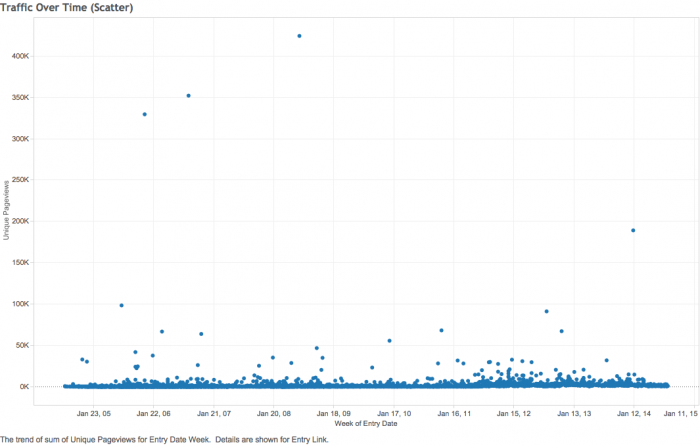
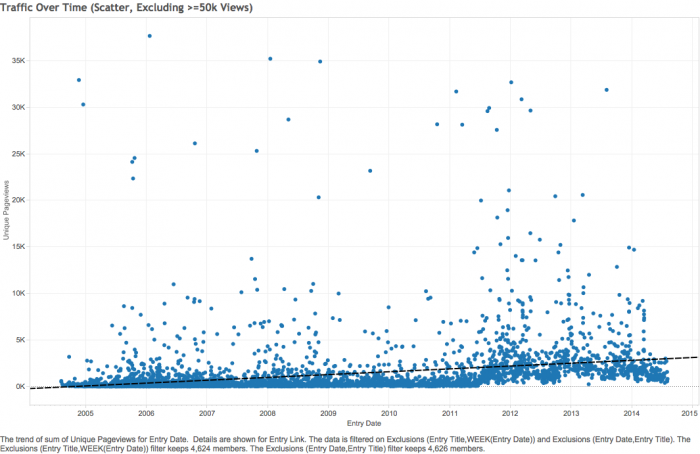
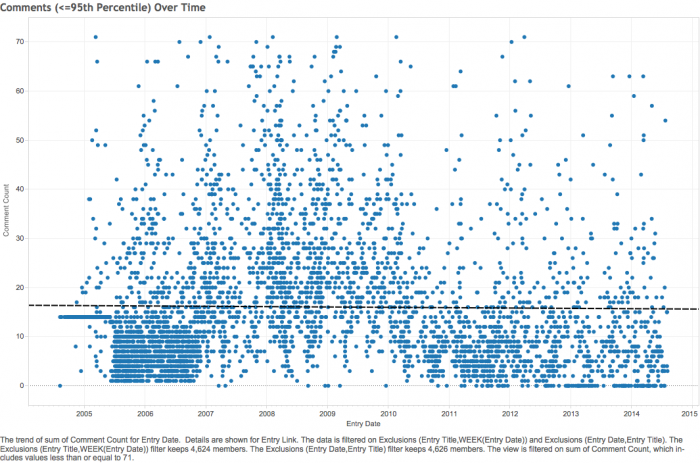
It’s really, really hard to separate correlation from causation here: did comment activity drop over the last two years (partially) because of Disqus, or did our introduction of Disqus coincide with other factors? Someone better at stats than I might be able to build a model with the data I’ve gathered, but I am not that person.
Part of the decrease in comment activity, I suspect, is because at least some of the commentary is moving to Facebook and other spaces where links are shared and discussed. The blogs have received more than 51,000 ‘engagements’ (== sum of total shares + total comments upon shared links) on Facebook since it started keeping records. The blogs with the most Facebook engagement are:
- 50 Things by Ben at ~21k
- Meltdown by Lydia at ~4400
- Stephen, I’m Putting You On Notice! by Stu at ~1900
- It’s More Than A Job by Ben at ~1200
- Invasion MIT! by me at ~1200
So there’s a tremendous dropoff with Facebook engagement as well; Ben’s 50 Things post accounts for almost half of all Facebook engagement, ever! Here’s how much of an outlier it is: although the mean Facebook engagement for any blog post is 11, the 90th percentile is only 8, and the median is 0. In fact, 3433 (~74%) of blog posts have never been engaged with on Facebook. There is a slight but evident uptick in Facebook engagement over time, but probably not enough to account by itself for the drop in comments:

According to CLIFF, the blogs have talked about ~4500 distinct organizations and ~8200 distinct people. The five most discussed organizational entities were:
- MIT at ~3100 mentions
- IAP at 290 mentions
- Harvard at 244 mentions
- Google at 152 mentions
- ECs at 137 mentions
(keep in mind that these are specific formulations of an entity: i.e., it does not recognize that IAP and Independent Activities Period are the same thing)
As for people, well, we’re a navel-gazing bunch: of the 10 most talked about people on the blogs, 9 of them are bloggers, and one of them is a blogger’s husband (the only thing Mollie loves talking about more than MIT is Adam, apparently!).
Of somewhat more interest (to me, anyway) are the geoparsing results, which allow us to plot which bloggers (and blog entries) mentioned which places in the world in their entries:
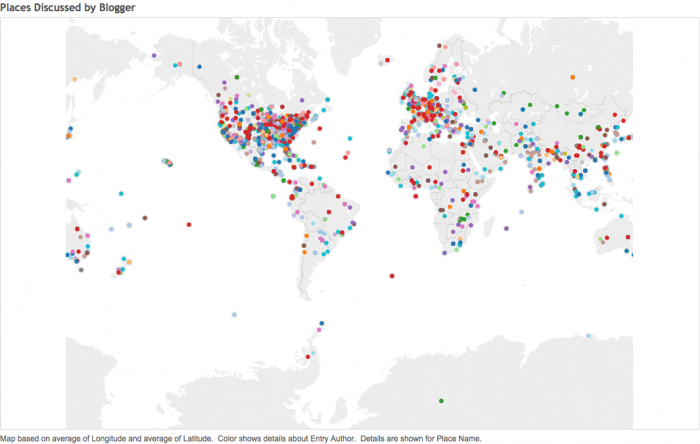
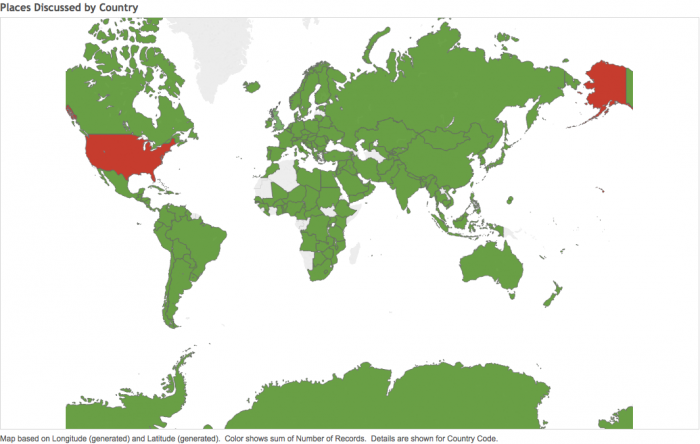
The Next 10 Years
We’ve spent the last week celebrating where the blogs came from and where the blogs have been over the last ten years. But there’s another question that’s just as – if not even more – important: where are the blogs going?
The straightforward, initial answer is “nowhere.” We love the blogs, and so do our applicants; we have tremendous support for the blogs within and without MIT, and we could easily keep on as we’ve been keeping on for the last ten years into the indefinite future.
But I would be lying if I weren’t concerned about the next ten years of the blogs – or, more specifically, how we help current MIT students tell their stories to prospective MIT students. The problem, as I see it, isn’t whether we can continue running the blogs (we can) or continue finding bloggers (we will). The problem is whether or not the audience will continue to be there, and whether that audience will just be the people who already know and love MIT, or whether we can continue to help reach out and introduce well-matched students to MIT.
As Ben noted, the web has changed so, so, so much since the blogs were founded. Anyone reading this post I suspect is familiar with the fundamental dynamics I’m describing so I won’t belabor them here. Suffice to say that, in 2004, there were barely any social network sites as we know them today, and so a college admissions site with a) student-written blogs and b) open comments was a kind of godsend for those who might want to get a sense of what life was like at that particular campus. In 2014, those conversations and connections are overwhelmingly occuring through a few social media channels (Facebook, Twitter, tumblr, etc); instead of being centralized around and faciliated by a given institution, they are facilited by those channels and decentralized to friends and peers. And, frankly, our bloggers post a lot more to Facebook and Twitter and Instagram and so on than they do to the blogs, because that’s where their friends are.
College admissions officers are often described using the metaphor of ‘gatekeepers.’ For almost ten years, we ran a little social club out in front of our gate, where people could gather and talk and hear stories and learn about what was behind the gate. Every year a few of them would try to pass through the gate; only some of them would make it, but even if they didn’t, they could still (and often did) keep chatting with the folks hanging out in front of the gate. Now, we’re still keeping the gate, and still hosting a little club in front of it, but the conversations are mostly happening elsewhere. Now, when people come to the gate, it is often headlong as an applicant, and perhaps without even the knowledge that there is the opportunity to learn about MIT ahead of time.
I’ll be dead honest: I don’t know what to do. I have some ideas. We’ve talked about redesigning the homepage so that, in addition to the blogs, you also get a ‘firehose’ of blogger Instagram pictures, tweets, and tumblr posts. We’ve even talked about transitioning the blogs entirely over to tumblr (or whatever) and just using the homepage to link out to completely decentralized blogger tumblrs. We’re not going to do either of these in the immediate term (or maybe ever). But I have come to the conclusion that, for a variety of (mostly exogenous) reasons, the blogs need to adapt to the changing digital ecosystem in which they are embedded.
What form that adaptation should or could or needs to take, I’m not sure. And I want to emphasize that our strategy/values (open, student-led communication to and with prospective students) remain the same they’ve always been. The question is how we tactically implement that strategy to make sure that a someone of the Class of 2019 finds whatever is at MITAdmissions.org as useful and meaningful and relevant as someone from the Class of 2009 did. And if you have suggestions about how to do that then please let me know.
Mostly, though, I’m just incredibly happy to have had the opportunity to help lead the blogs through almost half their life, to work with the students and staff who make it possible, to speak with the applicants for whom it was built, and generally to be a part of this ongoing whatever-it-is. Even though (because?) the next five, or ten, or twenty are uncertain, I can’t wait to see what they bring.